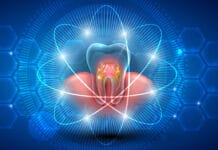Disclosure: This quiz is sponsored content from Premier Dental as part of our sponsored partner program.
Test your ergonomics knowledge with this quick quiz and then enter to win an AeroPro™ Cordless Prophy System from Premier Dental!
Ergonomics is defined as the study of the interaction of individuals and their jobs. By adhering to ergonomic best practices and implementing ergonomic interventions, the individual can increase comfort, productivity, and workplace safety.
True. Various reports cite the majority of dental hygienists, and dental practitioners as a whole, are at risk for musculoskeletal disorders even though they are aware of the risk and best practices. Ergonomics is defined as the study of the interaction of individuals and their jobs. By adhering to ergonomic best practices and implementing ergonomic interventions, the dental hygienist can increase comfort, productivity, and workplace safety. In general, dental hygienists should remain in neutral posture, actively move when providing clinical care, and use as little force as possible to accomplish the task.
Sanders, M.J., Michalak Turcotte, C. Posture Makes Perfect. Dimensions of Dental Hygiene. November 2011: 9(11):30-32, 35. Retrieved from https://dimensionsofdentalhygiene.com/article/posture-makes-perfect/
Which of the following are signs of carpal tunnel syndrome?
In 2001, 79% of dental hygienists reported having to take time off of work due to issues and symptoms caused by repetitive motions. Specifically, more than half reported having to take time off due to carpal tunnel syndrome. Carpal tunnel syndrome is brought on by muscles that fatigue thanks to excessive extension and use. Frequent signs include hand cramping, pain, stiffness, and difficulty opening jars. Common symptoms of carpal tunnel syndrome include decreased grip strength, pain at night, and limited range of motion of the wrist.
Simmer-Beck M, Branson B. Noting harmful chair side postures through assessment and observation and making necessary adjustments can make the difference in maintaining a healthy career in dental hygiene. Dimensions of Dental Hygiene. 2005;3(5):14, 16–19.
It is better ergonomic practice for a dental hygienist to hold their body in one position when providing care instead of actively moving and changing positions.
False. Though remaining in one, static position when providing clinical care may appear to be restful and non-fatiguing, it is actually the opposite that is true: actively moving and changing positions during treatment allows for muscle contraction and relaxation which promotes blood flow, circulation of nutrients, and removal of waste products. When the body is held in one position for an extended period of time, static forces are created wherein the body works against gravity. An example of this is holding one’s shoulder away from the body, which leads to tensed muscles, compressed blood flow, decreased oxygen, and pain and discomfort.
Sanders, M.J., Michalak Turcotte, C. Posture Makes Perfect. Dimensions of Dental Hygiene. November 2011: 9(11):30-32, 35. Retrieved from https://dimensionsofdentalhygiene.com/article/posture-makes-perfect/
According to a 5-year follow-up study conducted on 90 dental professionals, it was found that dental professionals had an average risk of developing musculoskeletal disorders.
In 1999, a follow-up study was completed that included 90 dental professionals and explored the course of musculoskeletal disorders during a 5-year period. Participants reported their symptoms and diagnoses via a survey and questionnaire. It was found that dental professionals had an increased risk of developing musculoskeletal disorders. Participants who completed the study had an increased risk of developing symptoms in the shoulders, elbows, wrists, and hands. Interestingly, some study participants reported leaving clinical practice during the five years due to pain and symptoms.
Åkesson, I., Johnsson, B., Rylander, L. et al. Int Arch Occup Environ Health (1999) 72: 395. https://doi.org/10.1007/s004200050391
Which of the following are best ergonomic tools and practices for dental practitioners?
When it comes to ideal ergonomic practice for the dental hygienist, a general rule of thumb is the more flexible and custom the tool, the better it is for the operator. For instance, the majority of dental practices today only supply ambidextrous gloves for clinical providers, which may cause tightness, soreness, and potential hand problems down the road. Many older dental units included handpieces with tightly coiled cords; instead, opt for modern units with lightweight cords which provide less drag. In recent years, hand instruments have also been redesigned to be lightweight and include textured, wide handles to allow for a more natural grasp. Finally, lightweight and cordless prophy handpieces are now available that reduce hand fatigue and improved access and comfort.
Park J. Ergonomics: Health Implications for Dental Hygienists. Slideshare website. http://www.slideshare.net/jhpdc/ergonomics-for-dental-hygienists-1178564. Published March 21, 2009.








